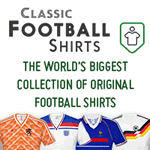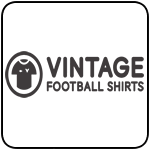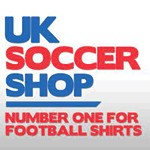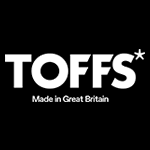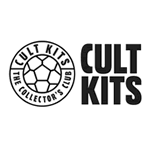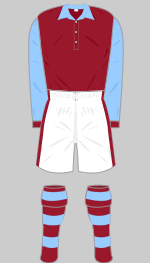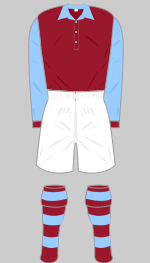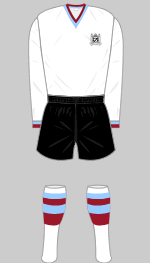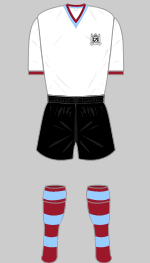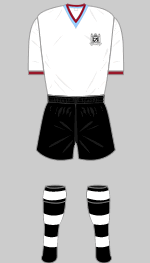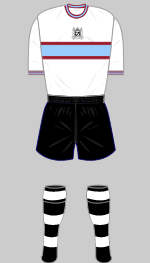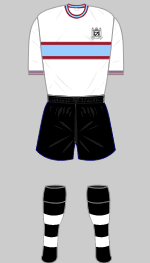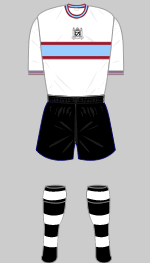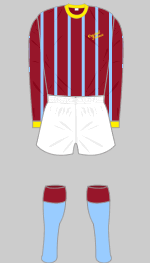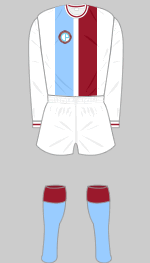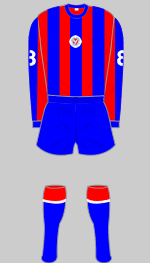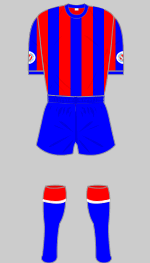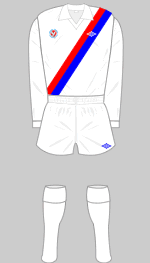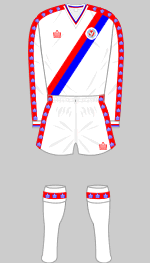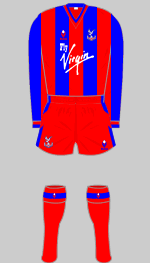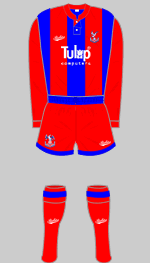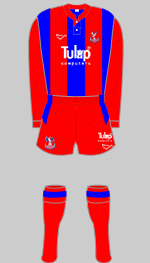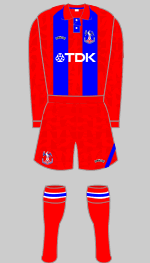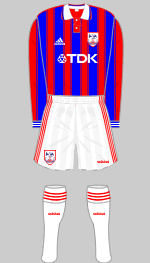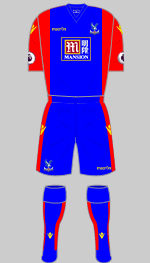Kit History

1905-1907 b t

1907-1908 c t
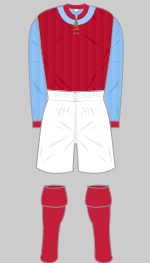
1908-1910 c p t
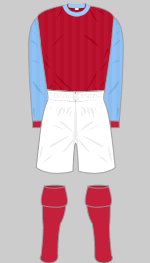
1910-1911 p t
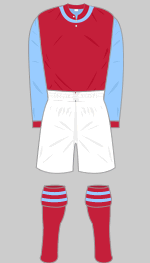
1911-1912 c p t
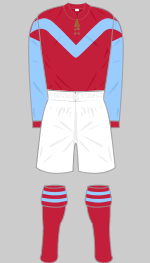
1912-1913 c g s t

1914-1915 c t

1919-1923 b h m p t

1923-1924 h t

1924-1926 c p t
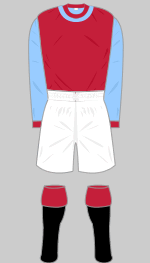
1926-1929 b j t
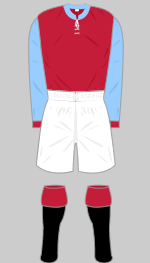
1929-1931 c o t
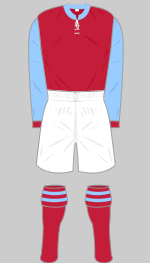
1933-1934 c t

1935-1936 c g o t
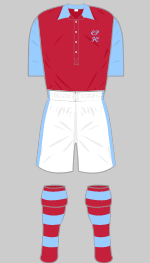
1936-1937 o
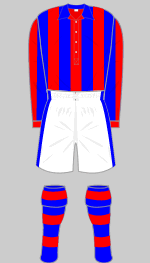
1937-1938 c g p t
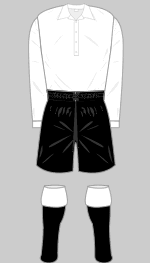
1938-1940 b
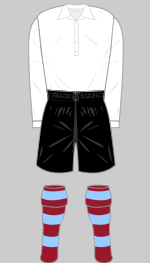
1946-1948 c
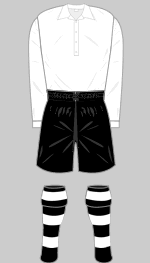
1948-1949 c
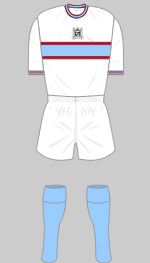
Sept 1962*
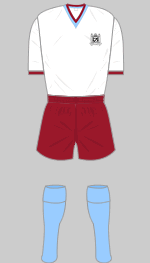
1962-1963* b u
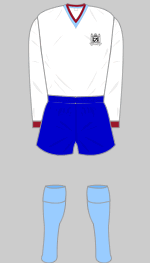
1963-1964 2 b c u
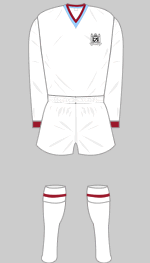
1963-1964 3 c u
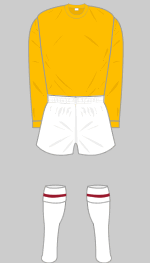
1963-1964 4 c u
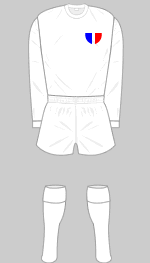
1964-1966 b
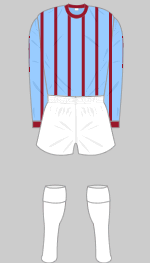
1966-Jan 1967 b
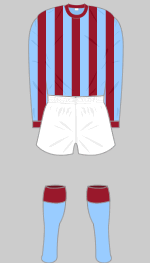
10 Dec 1966 w
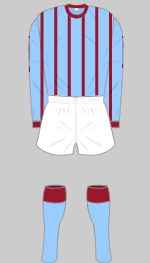
Jan-April 1967 m
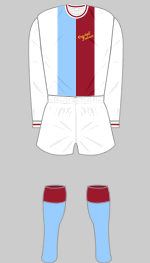
1971-1972 b h
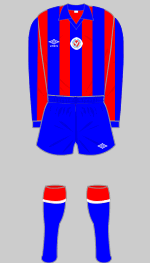
1975-1976 Cold b
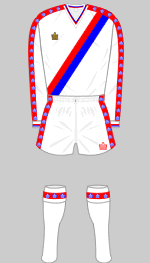
August 1977 v

September 1977 v
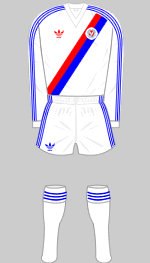
1980-1983 b
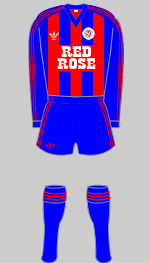
1983-1984 b x
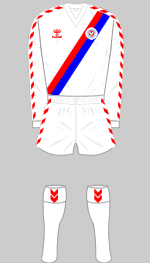
1984-1985 b
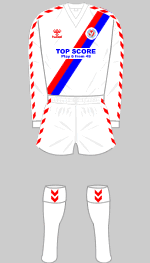
1985-1986 b h
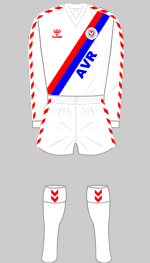
1986-1987 b
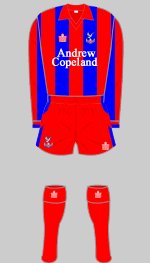
1987-Feb 88 b l x
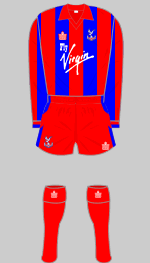
Feb-May 1988 x
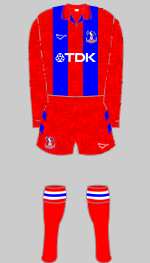
1993-1994 d l
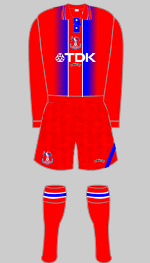
1995-1996 b h l
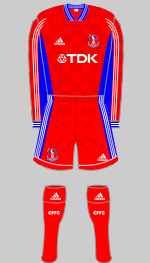
1998-1999 b

2000-2001 h x

2001-2002 e x

2002-2003 e
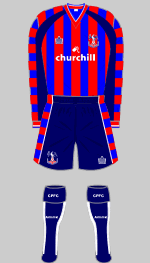
2003-2004 f h
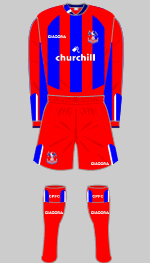
2004-2005 f i
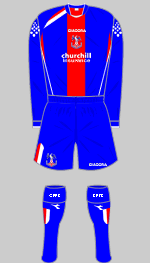
2005-2006 f
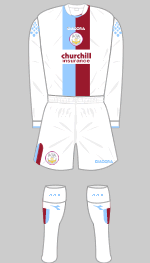
2005 Centenary c l
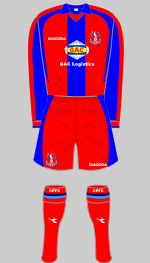
2006-2007 f

2007-2008 f

2008-2009 f n
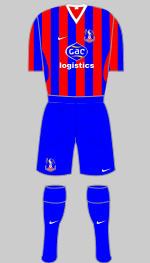
2009-2010 f
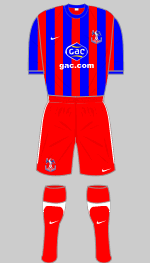
2010-2011 q
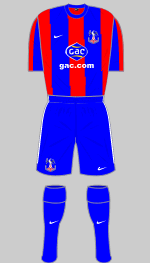
2011-2012 f
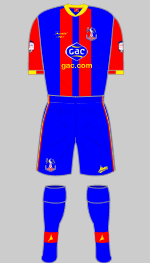
2012-2013 f
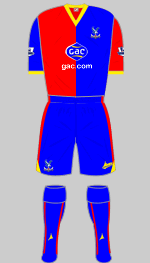
2013-2014 f
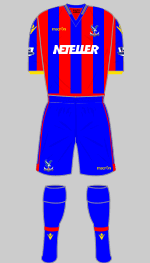
2014-2015 f
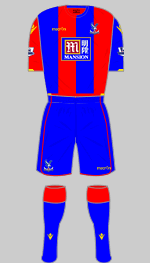
2015-2016 f
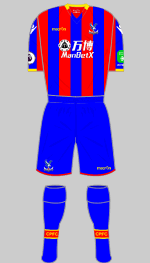
2017-2018 f
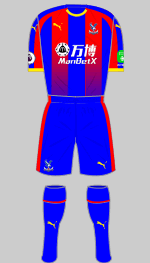
2018-2019 f
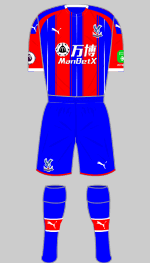
2019-2020 f

2020-2021 f
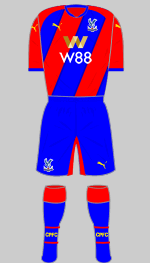
2021-2022 f

2022-2023 f

2023-2024 f *
Background
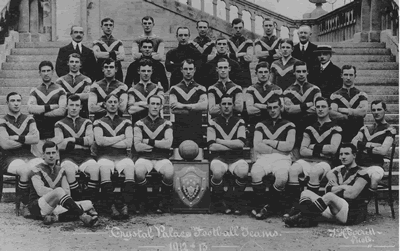 The original
Crystal Palace FC was formed by members of the Crystal Palace Cricket Club (formed 1857) in 1861, both tenants of the Crystal Palace Company who ran the former Great Exhibition building and associated park after it was relocated from Hyde Park to Sydenham in 1852. An influential club in the formative years of association football, Palace were founder members of the FA and took part in the first FA
Cup competition in 1871.
The original
Crystal Palace FC was formed by members of the Crystal Palace Cricket Club (formed 1857) in 1861, both tenants of the Crystal Palace Company who ran the former Great Exhibition building and associated park after it was relocated from Hyde Park to Sydenham in 1852. An influential club in the formative years of association football, Palace were founder members of the FA and took part in the first FA
Cup competition in 1871.
In his book, "Palace at the Palace," Peter Manning notes that the team did not play any fixtures in the park itself after January or February of each season. This was, he argues, to allow the pitch to recover in time for the cricket season, which was far more important. The last fixture played in Crystal Palace Park was on 9 January 1875 and all the remaining matches were played away from home. Ten matches were played in the first half of season 1875-76, implying that football was now banned from the park altogether. Eight further away fixtures were planned for January-March 1876 but did not take place. Research by Mark Metcalf and Clive Nicholson has established there was no Crystal Palace club affiliated to the FA after 1875 and it is clear that the club closed down.
In 1892 members of Surrey Cricket Club were voicing concern over damage caused to their own pitch (England's home internationals and the FA Cup final were traditionally played at the Oval) and this led to a ban in 1893. As there were no other suitable venues in London at the time, Henry Gillman, Entertainments Manager for the Crystal Palace Company proposed filling in a large and neglected area of fountains and basins situated in front of a terrace in order to build a dedicated football stadium capable of holding more than 100,000 spectators. The Palace became the regular venue for FA Cup finals until the outbreak of the First World War.
A Crystal Palace football team made an appearance for a friendly against Everton on 30 November 1895 and was scheduled to meet Sheffield United but they were unable to raise a side. Two further matches were played against the "German Football Association" (who turned out to be nothing of the sort) in September 1896 and Sheffield Wednesday (March 1897). Although Manning argues that these were a continuation of the original amateur club, after a hiatus of almost 20 years this seems unlikely. Furthermore only two players (MH Stanborough and JH Gettins) appeared in more than one match. Metcalf & Nicholson have shown that the teams were made up primarily of Corinthians players and that these were exhibition games.
In 1901, Henry Gillman, now General Manager of the Crystal Palace Company proposed forming a professional football team but this was rejected by the FA who frowned on the idea of the owners of the FA Cup final venue also owning a professional team. A later attempt by Dr WG Grace to set up a new football club collapsed in March 1905 and it fell to a new board of directors with the help of Edmund Goodman, who had five years experience with Aston Villa, to incorporate the Crystal Palace Football & Athletic Co Ltd. Although the Crystal Palace Company invested heavily in the new venture, they did not control the football club.
The club's minute book records that at a committee meeting held on 5 July 1905 "it was resolved that the club colours would be Cardinal and Blue jerseys and white knickers." Extensive research by Steve Martyniuk has established that "cardinal" was consistently used in all official documents until 1937.
In 1920 Palace became
founder members of the new Third Division, winning the title at the first
attempt. After four difficult years in Division Two, they dropped back
into Division Three 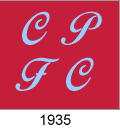 (South) in 1925 and remained there for the next 33
years. Their 1925 and 1935-37 kits, incidentally, featured pale stockings with
dark tops, a pattern that did not otherwise appear until the mid-1950s.
(South) in 1925 and remained there for the next 33
years. Their 1925 and 1935-37 kits, incidentally, featured pale stockings with
dark tops, a pattern that did not otherwise appear until the mid-1950s.
The first recorded evidence of the team wearing a crest was in the 1935-36 season, when the club's initials were embroidered onto their shirts.
For 1937-38 striped shirts were introduced for the first time and match programmes described these as "red and blue."
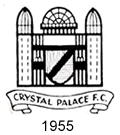 The following season plain white shirts were adopted in an attempt to
change Palace's fortunes but to no avail.
The following season plain white shirts were adopted in an attempt to
change Palace's fortunes but to no avail.
The first claret and blue shirts were introduced in 1949 and used until 1955 when white shirts with claret and blue trim appeared. These featured a new crest representing the famous facade of the original Crystal Palace and were worn until 1964.
In 1958 Palace were in the new Fourth Division with little prospect of success. Clad in a distinctive white shirt with claret and blue bands, Palace won promotion in 1961. Towards the end of the 1963-64 season, they switched to playing in their "lucky" amber change kit for home games: this seemed to do the trick
In April 1962 Palace played Real Madrid in a friendly to celebrate the installation of their new floodlights. The all-white strips worn over the next few seasons (as second or first choice) are often thought to be a tribute to the European Champions.
The 1962-64 seasons are rather confusing. The team started 1962-63 in the strip from the previous season (*white shirts claret/blue/claret bands, black shorts, later white shorts) before switching to *white shirts with claret and blue trim and claret shorts (the shirts being a holdover from 1955-59. Sometime early in 1963-64 royal blue shorts and long  sleeved shirts were adopted. Later on they played in all-white and towards the end of the season they switched to their "lucky" amber change tops. This seemed to do the trick as they won
promotion to Division Two.
sleeved shirts were adopted. Later on they played in all-white and towards the end of the season they switched to their "lucky" amber change tops. This seemed to do the trick as they won
promotion to Division Two.
 In 1964 Palace adopted an all white kit adorned with a simple crest in red, white and blue. The official crest continued to be a sketch of the original Crystal Palace but this did not appear on the team shirts.
In 1964 Palace adopted an all white kit adorned with a simple crest in red, white and blue. The official crest continued to be a sketch of the original Crystal Palace but this did not appear on the team shirts.
Claret and blue was reintroduced in 1966; initially the shirts were light blue with claret candy stripes (similar to their change strip worn four years earlier). Conventional stripes were worn on at least one occasion. In 1967 the colours were reversed. This fondly remembered strip  featured the club's name embroidered in full in gold script, making for an attractive contrast.
featured the club's name embroidered in full in gold script, making for an attractive contrast.
In 1969, Palace were promoted once again
and took their place in Division One for the first time. Clearly out of
their depth and with limited financial resources, Palace managed to stave
off relegation for four years before they went into free-fall and dropped
straight down into the Third Division. In 1971 another favourite strip was introduced, basically all white with broad claret and light blue panels on the chest. The first version 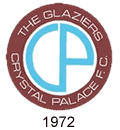 bore the gold embroidered script but when a new version was introduced in 1972, with a narrow white stripe separating the claret and blue, this was replaced by a circular badge in modernist style. Included in the design was the team's traditional nickname, "The Glaziers."
bore the gold embroidered script but when a new version was introduced in 1972, with a narrow white stripe separating the claret and blue, this was replaced by a circular badge in modernist style. Included in the design was the team's traditional nickname, "The Glaziers."
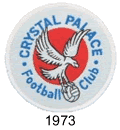 The flamboyent Malcolm Allison was brought in
as manager in late 1973 and while he could not keep the club in the Second Division,
he did transform them, laying the foundations for future success. Out
went the old badge and nickname to be replaced
by the more dramatic "Eagles." The traditional claret and light
blue colours were ditched in favour of red and blue. To add to what would now be called a re-branding exercise, numbers were worn on shirt sleeves in 1973-74 and the following season the new badge adorned the sleeves instead.
The flamboyent Malcolm Allison was brought in
as manager in late 1973 and while he could not keep the club in the Second Division,
he did transform them, laying the foundations for future success. Out
went the old badge and nickname to be replaced
by the more dramatic "Eagles." The traditional claret and light
blue colours were ditched in favour of red and blue. To add to what would now be called a re-branding exercise, numbers were worn on shirt sleeves in 1973-74 and the following season the new badge adorned the sleeves instead.
After narrowly missing promotion three times, Allison called it a day and Terry Venables took over as manager. Venables steered Palace all the way back into the First Division with a side dubbed "the Team of the Eighties." They failed to live up to this reputation and were relegated in 1981 after only two seasons at the top. Venables left the club in his usual controversial circumstances and Palace, now almost bankrupt, descended into chaos.
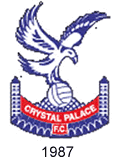 The club's saviour turned out to be Steve Coppell,
recently retired as a player and appointed to his first managerial job in 1984, a job he retained until 1993. Coppell
brought stability and proved to be an outstanding judge of young talent.
Many of the youngsters he signed for a pittance were sold on for multi-million
pound transfer fees, bringing much needed revenue to the club. With Coppell
in charge, Palace adopted a revised crest in 1987 and returned to the First Division in 1989. The following
year they reached the FA
The club's saviour turned out to be Steve Coppell,
recently retired as a player and appointed to his first managerial job in 1984, a job he retained until 1993. Coppell
brought stability and proved to be an outstanding judge of young talent.
Many of the youngsters he signed for a pittance were sold on for multi-million
pound transfer fees, bringing much needed revenue to the club. With Coppell
in charge, Palace adopted a revised crest in 1987 and returned to the First Division in 1989. The following
year they reached the FA 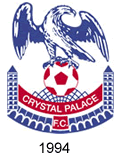 Cup final for the first time. A year later, Palace
finished third behind Arsenal and Liverpool. In 1992, however, the club
was relegated and Coppell resigned. The club moved between
the two top divisions with bewildering regularity, sporting a a series
of eye catching and original kits, not all of which have met with approval
from fans. Their 2003-04 kit was, for example dubbed the "Ronald
MacDonald" kit because of the hooped sleeves.
Cup final for the first time. A year later, Palace
finished third behind Arsenal and Liverpool. In 1992, however, the club
was relegated and Coppell resigned. The club moved between
the two top divisions with bewildering regularity, sporting a a series
of eye catching and original kits, not all of which have met with approval
from fans. Their 2003-04 kit was, for example dubbed the "Ronald
MacDonald" kit because of the hooped sleeves.
In 2005, the club's centenary year, a special kit, chosen by supporters and modeled on the classic 1971 version was worn in a pre-season friendly and two home league games.
In 2009-10, the club was placed in administration for the second time after the chairman, Simon Jordan failed to attract new investment, HMRC took out a winding up order over unpaid taxes and the players were paid late on two occasions. The ten point penalty 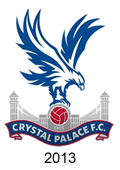 took the team from a comfortable mid-table position in the Championship to just above the relegation zone but they retained their place on the last day of the season. A consortium of wealthy supporters, CPFC 2010, bought both the freehold on the ground and the club itself during the close season to ensure their survival.
took the team from a comfortable mid-table position in the Championship to just above the relegation zone but they retained their place on the last day of the season. A consortium of wealthy supporters, CPFC 2010, bought both the freehold on the ground and the club itself during the close season to ensure their survival.
Palace's fortunes improved and in 2013, they reached the Championship play-off final where they beat Watford with a penalty in extra time. Furthermore, a new crest was designed after an extensive exercise of fan consultation and crowd-sourcing, to be worn  from the start of the 2013-14 season in the Premier League.
from the start of the 2013-14 season in the Premier League.
Palace reached the FA Cup final in 2015-16 and took the lead in the 79th minute only for Manchester United to equalise moments later. United scored again in extra time to deny Palace the trophy.
Although claims that the modern club is linked to the original Crystal Palace FC have been comprehensively disproved by Metcalf and Nicholson, the club persisted in promoting itself as having been formed in 1861. In 2022 the club crest was modified by replacing "1905" with the earlier date.
Sources
- (a) Club Colours (Bob Bickerton 1998)
- (b) Crystal Palace FC (Images of Sport - Rev Nigel Sands)
- (c) Classic Kits is run by Andy Burton and is extensively referenced throughout this site. Andy is a Palace fan and has extremely detailed information about their kits. Well worth a visit.
- (d) Sporting Heroes
- (e) empics
- (f) Crystal Palace Official Website
- (g) 100 Years of Crystal Palace (Nigel Sands 2005)
- (h) Andy Burton
- (g) Bjørn-Terje Nilssen
- (h) David London
- (i) David King
- (j) Peter Moor
- (k) Football League Review
- (l) True Colours 2 (John Devlin 2006)
- (m) Pete's Picture Palace
- (n) Fabrizio Taddei (Errea)
- (o) Simon Monks
- (p) Keith Ellis
- (q) Rob Rob
- (r) Nick Szczepanik
- (s) Gottfried Fuchs Blogspot
- (t) The Origin of Crystal Palace FC Volume 2 (Steve Martyniuk 2017)
- (u) Pinterest
- (v) Tony Sealey
- (w) The Senior Tigers Club
- (x) Nik Yeomans
- (y) 1999-2000 shirts sponsor photographs courtesy of Old Football Shirts
* Kit graphic by Daniel Stoker
Crests are the property of Crystal Palace FC. Thanks to Andy Burton for supplying crest artwork 1960-1973.
